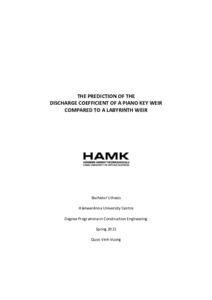The prediction of the Discharge Coefficient of a Piano Key Weir compared to a Labyrinth Weir.
Vuong, Quoc Vinh (2021)
Vuong, Quoc Vinh
2021
All rights reserved. This publication is copyrighted. You may download, display and print it for Your own personal use. Commercial use is prohibited.
Julkaisun pysyvä osoite on
https://urn.fi/URN:NBN:fi:amk-202103223680
https://urn.fi/URN:NBN:fi:amk-202103223680
Tiivistelmä
Weirs are free-surface hydraulic structures built across open channels, such as rivers or lakes, to control the upstream flow of water. As they are passive hydraulic control barriers, it is critical to understand how the geometry specifications and discharge efficiency contribute to the sufficiency and safety of a weir’s operation.
A Labyrinth Weir is a non-linear weir which has been configurated in a zigzag geometry with increase in weir length within a fixed channel width. A Piano Key (PK) Weir, developed as an alternative for a traditional Labyrinth Weir, is another type of non-linear weir used particularly for free-surface flow control structures with relatively small channel footprints. Non-linear weirs are used rather than linear weirs due to their significant increase in discharge efficiency within the restricted channel and spillway footprints.
To have a better understanding of the effects of different weir geometries on discharge efficiency, a laboratory-scale, 2-cycle Trapezoidal Labyrinth (TL) Weir, in both aerated and unaerated situations, were tested. Hypothetical data of a laboratory-scale, 2-cycle PK Weir were also predicted based on the physical model of hydraulics. As a result, the influence of the following PK and TL Weir’s geometries/modifications were recognized: TL Weir with normal and inverse orientation, PK Weir with and without ramps, both on the inlet and outlet keys. Based on the experimental and hypothetical results, the discharge coefficient and head-discharge relationships were evaluated.
Previous research has found that the discharge rate of PK Weirs can be four times higher than TL Weirs. However, in this research, it was found that PK Weirs are from 23% to 135% more efficient in discharge efficiency compared to TL Weirs.
A Labyrinth Weir is a non-linear weir which has been configurated in a zigzag geometry with increase in weir length within a fixed channel width. A Piano Key (PK) Weir, developed as an alternative for a traditional Labyrinth Weir, is another type of non-linear weir used particularly for free-surface flow control structures with relatively small channel footprints. Non-linear weirs are used rather than linear weirs due to their significant increase in discharge efficiency within the restricted channel and spillway footprints.
To have a better understanding of the effects of different weir geometries on discharge efficiency, a laboratory-scale, 2-cycle Trapezoidal Labyrinth (TL) Weir, in both aerated and unaerated situations, were tested. Hypothetical data of a laboratory-scale, 2-cycle PK Weir were also predicted based on the physical model of hydraulics. As a result, the influence of the following PK and TL Weir’s geometries/modifications were recognized: TL Weir with normal and inverse orientation, PK Weir with and without ramps, both on the inlet and outlet keys. Based on the experimental and hypothetical results, the discharge coefficient and head-discharge relationships were evaluated.
Previous research has found that the discharge rate of PK Weirs can be four times higher than TL Weirs. However, in this research, it was found that PK Weirs are from 23% to 135% more efficient in discharge efficiency compared to TL Weirs.
